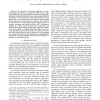Free Online Productivity Tools
i2Speak
i2Symbol
i2OCR
iTex2Img
iWeb2Print
iWeb2Shot
i2Type
iPdf2Split
iPdf2Merge
i2Bopomofo
i2Arabic
i2Style
i2Image
i2PDF
iLatex2Rtf
Sci2ools
CDC
2008
IEEE
2008
IEEE
Clustering neural spike trains with transient responses
— The detection of transient responses, i.e. non– stationarities, that arise in a varying and small fraction of the total number of neural spike trains recorded from chronically implanted multielectrode grids becomes increasingly difficult as the number of electrodes grows. This paper presents a novel application of an unsupervised neural network for clustering neural spike trains with transient responses. This network is constructed by incorporating projective clustering into an adaptive resonance type neural network (ART) architecture resulting in a PART neural network. Since comparisons are made between inputs and learned patterns using only a subset of the total number of available dimensions, PART neural networks are ideally suited to the detection of transients. We show that PART neural networks are an effective tool for clustering neural spike trains that is easily implemented, computationally inexpensive, and well suited for detecting neural responses to dynamic environmen...
| Added | 29 May 2010 |
| Updated | 29 May 2010 |
| Type | Conference |
| Year | 2008 |
| Where | CDC |
| Authors | John D. Hunter, Jianhong Wu, John G. Milton |
Comments (0)

